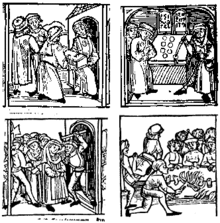We will have two ten-minute breaks: at 7:30 - 7:40; and, at 9:00 pm - 9:10 pm. I will take roll after the second break before you are dismissed at 10 pm.
Question 1: Multiple Choice
-
 In Franz Kafka's The Trial, why is protagonist Josef K. arrested and tried?
In Franz Kafka's The Trial, why is protagonist Josef K. arrested and tried?Given Answer:  For an unknown reason
For an unknown reasonCorrect Answer:  For an unknown reason
For an unknown reason
Question 2: Multiple Choice
-
 Why most likely did composer Sergei Prokofiev write the simplistic symphonic fairy tale Peter and the Wolf?
Why most likely did composer Sergei Prokofiev write the simplistic symphonic fairy tale Peter and the Wolf?Given Answer:  Satisfy Soviet authorities who called his music too complicated
Satisfy Soviet authorities who called his music too complicatedCorrect Answer:  Satisfy Soviet authorities who called his music too complicated
Satisfy Soviet authorities who called his music too complicated
Question 3: Multiple Choice
-
 How many Jews are estimated to have been exterminated at Auschwitz-Birkenau?
How many Jews are estimated to have been exterminated at Auschwitz-Birkenau?Given Answer:  1-2.5 million
1-2.5 millionCorrect Answer:  1-2.5 million
1-2.5 million
Question 4: Multiple Choice
-
 What "cosmic interaction" did Piet Mondrian believe the grid represented?
What "cosmic interaction" did Piet Mondrian believe the grid represented?Given Answer:  Masculine and feminine
Masculine and feminineCorrect Answer:  Masculine and feminine
Masculine and feminine
Question 5: Multiple Choice
-
 Why did the Nazis dislike the Bauhaus style?
Why did the Nazis dislike the Bauhaus style?Given Answer:  Rejected traditional German values
Rejected traditional German valuesCorrect Answer:  Rejected traditional German values
Rejected traditional German values
Question 6: Multiple Choice
-
 According to theologian Reinhold Niebuhr, what did religion provide the post-World War II alienated person?
According to theologian Reinhold Niebuhr, what did religion provide the post-World War II alienated person?Given Answer:  Courage to conquer despair
Courage to conquer despairCorrect Answer:  Courage to conquer despair
Courage to conquer despair
Question 7: Multiple Choice
-
 What in American society were the Beat artists reacting against?
What in American society were the Beat artists reacting against?Given Answer:  False values
False valuesCorrect Answer:  False values
False values
Question 8: Multiple Choice
-
 Why did Frank Lloyd Wright design the Guggenheim Museum in New York as a spiral with a ramp and an open rotunda in the middle?
Why did Frank Lloyd Wright design the Guggenheim Museum in New York as a spiral with a ramp and an open rotunda in the middle?Given Answer:  Visitors could see what they had viewed and what was to come
Visitors could see what they had viewed and what was to comeCorrect Answer:  Visitors could see what they had viewed and what was to come
Visitors could see what they had viewed and what was to come
Question 9: Multiple Choice
-
 What work best characterizes the Beat generation?
What work best characterizes the Beat generation?Given Answer:  Allen Ginsberg's "Howl"
Allen Ginsberg's "Howl"Correct Answer:  Allen Ginsberg's "Howl"
Allen Ginsberg's "Howl"
Question 10: Multiple Choice
To reap the full effect of David Smith's Blackburn: Song of an Irish Blacksmith, what must the viewer do?
|
|||||
| |||||
Pre-Built Course Content
MUSIC FOLDER
HUM111 Music for Week 9
In this week's readings (chaps. 17 and 18), there is one musical composition mentioned, and it is in chapter 17. This (or a decent equivalent) can be found on YouTube.
Watch and give this a listen. Here below is some background and
description of the work--and the link to the YouTube (and sometimes
other helps). After that, in connection with chapter 18, there is an additional item on traditional mask dances from West Africa.
- A Mighty Fortress Is Our God (Martin Luther) (chap. 17, p. 575)
-
- http://www.youtube.com/watch?v=G42xwWoUS-0 (p. 575) (See German text at http://www.musicanet.org/robokopp/Lieder/einfeste.html; English translation/lyrics can be found at http://www.musicanet.org/robokopp/hymn/amightyf.html )
Read carefully p. 575 in chap. 17.
This hymn was composed in 1529 by Martin Luther, the major Protestant
Reformer. It remains a popular hymn in Protestant churches worldwide.
-----------------------
Chapter
18 does not identify a musical selection for listening, but here is a
bonus on traditional West African dance, music, and masks.
- Dogon Mask Dance
In chapter 18 (pp. 608-610) discuss the importance of traditional West African dances wearing masks. The book mentions the banda mask dance (p. 608) as a cultural survival strategy; for this see also this link from the Neww York Metropolitan Museum: http://www.metmuseum.org/toah/works-of-art/1978.412.307 .
In a similar fashion, another West African society, the Dogon, is still living in traditional ways in isolated parts of Mali, and continues to celebrate a Dogon mask dance:
In a similar fashion, another West African society, the Dogon, is still living in traditional ways in isolated parts of Mali, and continues to celebrate a Dogon mask dance:
-
- https://www.youtube.com/watch?v=whAY9R-_7ac (See this 2-page National Geographic discussion of the Dogon and this dance: http://news.nationalgeographic.com/news/2003/05/0529_030529_dogon.html.)
REFORMATION
Pre-Built Course Content
CORTEZ
Pre-Built Course Content
MUGHUL EMPIRE AND THE TAJ MAHAL
Pre-Built Course Content
17 The Reformation A NEW CHURCH AND THE ARTS 569
The Protestant Reformation during the 16th century in Europe almost entirely rejected the existing tradition of Catholic art, and very often destroyed as much of it as it could reach. A new artistic tradition developed, producing far smaller quantities of art that followed Protestant agendas and diverged drastically from the southern European tradition and the humanist art produced during the High Renaissance. In turn, the Catholic Counter-Reformation both reacted against and responded to Protestant criticisms of art in Roman Catholicism to produce a more stringent style of Catholic art. Protestant religious art both embraced Protestant values and assisted in the proliferation of Protestantism, but the amount of religious art produced in Protestant countries was hugely reduced. Artists in Protestant countries diversified into secular forms of art like history painting, landscape painting, portrait painting and still life.
 Hans Holbein the Younger's Noli me tangere
a relatively rare Protestant oil painting of Christ from the
Reformation period. It is small, and generally naturalistic in style,
avoiding iconic elements like the halo, which is barely discernible.
Hans Holbein the Younger's Noli me tangere
a relatively rare Protestant oil painting of Christ from the
Reformation period. It is small, and generally naturalistic in style,
avoiding iconic elements like the halo, which is barely discernible. Reform
- Chapter 17 (pp. 571-3), Erasmus; (pp. 573-7), Reformation and the princes; (pp. 570-1; 579-580), printing press; (pp. 587-591), visual arts; review Week 9 Music Folder
Global Encounters: Achievements and Exploitation
- Chapter 18 (pp. 618-620), China’s Treasure Fleet; review Week 9 Music Folder
- Chinese explorers at http://www.pbs.org/wgbh/nova/ancient/ancient-chinese-explorers.html and http://www.alrahalah.com/2010/09/zheng-he/
- Large ship replica: http://www.alrahalah.com/wp-content/uploads/2010/09/TreasureShip.jpg
- Chapter 18 (pp. 596-604), Spain and Portugal: empire building; quick conquest
- Chapter 18 (pp. 601, 604-607, 612-613), transatlantic slave trade
- Transatlantic slave trade at http://www.pbs.org/wgbh/aia/part1/1p277.html
Erasmus, Luther, and the Reformation 571
Desiderius Erasmus Roterodamus (/ˌdɛzɪˈdɪəriəs ɪˈræzməs/; 28 October[1] 1466[2] – 12 July 1536), known as Erasmus of Rotterdam, or simply Erasmus,[note 1] was a Dutch Renaissance humanist, Catholic priest, social critic, teacher, and theologian.
Erasmus was a classical scholar and wrote in a pure Latin style. Among humanists he enjoyed the sobriquet "Prince of the Humanists", and has been called "the crowning glory of the Christian humanists".[3] Using humanist techniques for working on texts, he prepared important new Latin and Greek editions of the New Testament, which raised questions that would be influential in the Protestant Reformation and Catholic Counter-Reformation. He also wrote On Free Will,[4] The Praise of Folly, Handbook of a Christian Knight, On Civility in Children, Copia: Foundations of the Abundant Style, Julius Exclusus, and many other works.
Erasmus lived against the backdrop of the growing European religious Reformation, but while he was critical of the abuses within the Catholic Church and called for reform, he kept his distance from Luther and Melanchthon and continued to recognise the authority of the pope, emphasizing a middle way with a deep respect for traditional faith, piety and grace, rejecting Luther's emphasis on faith alone. Erasmus remained a member of the Roman Catholic Church all his life,[5] remaining committed to reforming the Church and its clerics' abuses from within. He also held to the Catholic doctrine of free will, which some Reformers rejected in favor of the doctrine of predestination. His middle road approach disappointed and even angered scholars in both camps.
Erasmus died suddenly in Basel in 1536 while preparing to return to Brabant, and was buried in the Basel Minster, the former cathedral of the city.[6] A bronze statue of him was erected in his city of birth in 1622, replacing an earlier work in stone.
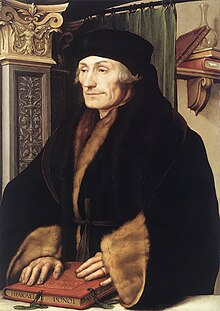 Desiderius Erasmus in 1523 as depicted by Hans Holbein the Younger. The Greek and Latin words on the book translate to "The Herculean Labours of Erasmus of Rotterdam"
Desiderius Erasmus in 1523 as depicted by Hans Holbein the Younger. The Greek and Latin words on the book translate to "The Herculean Labours of Erasmus of Rotterdam"Martin Luther (/ˈluːθər/ or /ˈluːðər/;[1] German: [ˈmaɐ̯tiːn ˈlʊtɐ] (
Luther taught that salvation and subsequently eternal life is not earned by good deeds but is received only as a free gift of God's grace through faith in Jesus Christ as redeemer from sin. His theology challenged the authority and office of the Pope by teaching that the Bible is the only source of divinely revealed knowledge from God[3] and opposed sacerdotalism by considering all baptized Christians to be a holy priesthood.[4]
Those who identify with these, and all of Luther's wider teachings, are called Lutherans even though Luther insisted on Christian or Evangelical as the only acceptable names for individuals who professed Christ.
His translation of the Bible into the vernacular (instead of Latin) made it more accessible, which had a tremendous impact on the church and German culture. It fostered the development of a standard version of the German language, added several principles to the art of translation,[5] and influenced the writing of an English translation, the Tyndale Bible.[6] His hymns influenced the development of singing in churches.[7] His marriage to Katharina von Bora set a model for the practice of clerical marriage, allowing Protestant clergy to marry.[8]
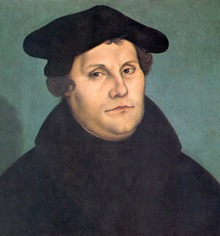 Luther (1529) by Lucas Cranach the Elder
Luther (1529) by Lucas Cranach the ElderThe Protestant Reformation, often referred to simply as the Reformation (from Latin reformatio, lit. "restoration, renewal"), was a schism from the Roman Catholic Church initiated by Martin Luther, John Calvin, Huldrych Zwingli and other early Protestant Reformers in the 16th century Europe.
Although there had been significant earlier attempts to reform the Roman Catholic Church before Luther — such as those of Jan Hus, Peter Waldo, and John Wycliffe — it is Martin Luther who is widely acknowledged to have started the Reformation with his 1517 work The Ninety-Five Theses. Luther began by criticizing the selling of indulgences, insisting that the Pope had no authority over purgatory and that the Catholic doctrine of the merits of the saints had no foundation in the gospel. The Protestant position, however, would come to incorporate doctrinal changes such as sola scriptura and sola fide. The core motivation behind these changes was theological, though many other factors played a part, including the rise of nationalism, the Western Schism which eroded people's faith in the Papacy, the perceived corruption of the Roman Curia, the impact of humanism and the new learning of the Renaissance which questioned much of the traditional thought.
The initial movement within Germany diversified almost right then and there, and other reform impulses arose independently of Luther. The spread of Gutenberg's printing press provided the means for the rapid dissemination of religious materials in the vernacular. The largest groups were the Lutherans and Calvinists. Lutheran churches were founded mostly in Germany, the Baltics and Scandinavia, while the Reformed ones were founded in Switzerland, Hungary, France, the Netherlands and Scotland. The new movement influenced the Church of England decisively after 1547 under Edward VI and Elizabeth I, although the national church had been made independent under Henry VIII in the early 1530s for political rather than religious reasons.
There were also reformation movements throughout continental Europe known as the Radical Reformation, which gave rise to the Anabaptist, Moravian, and other Pietistic movements. Radical Reformers, besides forming communities outside state sanction, often employed more extreme doctrinal change, such as the rejection of tenets of the councils of Nicaea and Chalcedon.
The Roman Catholic Church responded with a Counter-Reformation initiated by the Council of Trent. Much work in battling Protestantism was done by the well-organized new order of the Jesuits. In general, Northern Europe, with the exception of most of Ireland, came under the influence of Protestantism. Southern Europe remained Roman Catholic, while Central Europe was a site of a fierce conflict, culminating in the Thirty Years' War, which left it massively devastated.
Top 25 Protestant Reformers: Erasmus (#9), 8:56
https://youtu.be/8SajNjTEE_A
Martin Luther reformer's famous statement! 9:17
Luther combating great odds through the power of Holy Spirit and the
Word. However he didn't bring it totally back to the book of Acts but
he did make significant changes. Luther's famous dialogue captured the
hearts of many, clip from a film "Luther", based on the life of Martin
Luther by Joseph Fiennes. It is an inspirational, engrossing,
compelling and powerful film. Great quotes to setup or reframe Bible
studies.
https://youtu.be/tOWfTjkJc48
Looking at the opposing views from the Reformation. Posing the views of the Catholics (Johann Tetzel and Erasmus) and Protestants (Martin Luther and John Calvin) against each other in a fun and informative way.
The purpose is to offer students a chance to see how these figures view the same situation or event. This is the first video of this series.
https://youtu.be/KlOLTyH7Lkc
The Protestant Reformation Explained: World History Review, 7:30
A super fast, fun and focused look at the Protestant Revolution and role Martin Luther played in changing the history of the world. Subscribe to HipHughes to keep the universe aligned for free here https://www.youtube.com/user/hughesdv?
https://youtu.be/__X5Z9IztrM
The Satires of Erasmus 571
In Praise of Folly (Latin: Stultitiae Laus, sometimes translated as In Praise of More; Greek title: Morias Enkomion (Μωρίας Εγκώμιον); Dutch title: Lof der Zotheid) is an essay written in Latin in 1509 by Desiderius Erasmus of Rotterdam and first printed in 1511. Inspired by Italian humanist Faustino Perisauli's De Triumpho Stultitiae, it is a satirical attack on superstitions and other traditions of European society as well as on the western Church.
Erasmus revised and extended the work, which he originally wrote in the space of a week while sojourning with Sir Thomas More at More's estate in Bucklersbury. In Praise of Folly is considered one of the most notable works of the Renaissance and played an important role in the beginnings of the Protestant Reformation.[1]
In Praise of Folly starts off with a satirical learned encomium, in which Folly praises herself, after the manner of the Greek satirist Lucian, whose work Erasmus and Sir Thomas More had recently translated into Latin, a piece of virtuoso foolery; it then takes a darker tone in a series of orations, as Folly praises self-deception and madness and moves to a satirical examination of pious but superstitious abuses of Catholic doctrine and corrupt practices in parts of the Roman Catholic Church—to which Erasmus was ever faithful—and the folly of pedants. Erasmus had recently returned disappointed from Rome, where he had turned down offers of advancement in the curia, and Folly increasingly takes on Erasmus' own chastising voice. The essay ends with a straightforward statement of Christian ideals.
Erasmus was a good friend of More, with whom he shared a taste for dry humor and other intellectual pursuits. The title "Morias Encomium" can also be read as meaning "In praise of More". The double or triple meanings go on throughout the text.
The essay is filled with classical allusions delivered in a style typical of the learned humanists of the Renaissance. Folly parades as a goddess, offspring of Plutus, the god of wealth and a nymph, Freshness. She was nursed by two other nymphs, Inebriation and Ignorance. Her faithful companions include Philautia (self-love), Kolakia (flattery), Lethe (forgetfulness), Misoponia (laziness), Hedone (pleasure), Anoia (madness), Tryphe (wantonness), and two gods, Komos (intemperance) and Eegretos Hypnos (dead sleep). Folly praises herself endlessly, arguing that life would be dull and distasteful without her. Of earthly existence, Folly pompously states, "you'll find nothing frolic or fortunate that it owes not to me."
Moriae Encomium was hugely popular, to Erasmus' astonishment and sometimes his dismay. Even Erasmus' close friends had been initially skeptical, and warned him of possible dangers to himself from thus attacking the established religion. Leo X thought it was funny. Before Erasmus' death it had already passed into numerous editions and had been translated into Czech, French and German. An English edition soon followed. It influenced teaching of rhetoric during the later sixteenth century, and the art of adoxography or praise of worthless subjects became a popular exercise in Elizabethan grammar schools: see Charles O. McDonald, The Rhetoric of Tragedy (Amherst, 1966). A copy of the Basel edition of 1515/16 was illustrated with pen and ink drawings by Hans Holbein the Younger.[2] These are the most famous illustrations of The Praise of Folly.
Its role in the beginnings of the Protestant Reformation[1] stem from the foundation of critique which the essay laid against the practices of the Church and its political allies.[3]
From 1510 to 1520, Luther lectured on the Psalms, the books of Hebrews, Romans, and Galatians. As he studied these portions of the Bible, he came to view the use of terms such as penance and righteousness by the Catholic Church in new ways. He became convinced that the church was corrupt in its ways and had lost sight of what he saw as several of the central truths of Christianity. The most important for Luther was the doctrine of justification – God's act of declaring a sinner righteous – by faith alone through God's grace. He began to teach that salvation or redemption is a gift of God's grace, attainable only through faith in Jesus as the Messiah.[40] "This one and firm rock, which we call the doctrine of justification," he wrote, "is the chief article of the whole Christian doctrine, which comprehends the understanding of all godliness."[41]
Luther came to understand justification as entirely the work of God. This teaching by Luther was clearly expressed in his 1525 publication On the Bondage of the Will, which was written in response to On Free Will by Desiderius Erasmus (1524). Luther based his position on predestination on St. Paul's epistle to the Ephesians 2:8–10. Against the teaching of his day that the righteous acts of believers are performed in cooperation with God, Luther wrote that Christians receive such righteousness entirely from outside themselves; that righteousness not only comes from Christ but actually is the righteousness of Christ, imputed to Christians (rather than infused into them) through faith.[42] "That is why faith alone makes someone just and fulfills the law," he wrote. "Faith is that which brings the Holy Spirit through the merits of Christ."[43] Faith, for Luther, was a gift from God; the experience of being justified by faith was "as though I had been born again." His entry into Paradise, no less, was a discovery about "the righteousness of God" – a discovery that "the just person" of whom the Bible speaks (as in Romans 1:17) lives by faith.[44] He explained his concept of "justification" in the Smalcald Articles:
The first and chief article is this: Jesus Christ, our God and Lord, died for our sins and was raised again for our justification (Romans 3:24–25). He alone is the Lamb of God who takes away the sins of the world (John 1:29), and God has laid on Him the iniquity of us all (Isaiah 53:6). All have sinned and are justified freely, without their own works and merits, by His grace, through the redemption that is in Christ Jesus, in His blood (Romans 3:23–25). This is necessary to believe. This cannot be otherwise acquired or grasped by any work, law or merit. Therefore, it is clear and certain that this faith alone justifies us ... Nothing of this article can be yielded or surrendered, even though heaven and earth and everything else falls (Mark 13:31).[45]Luther's rediscovery of "Christ and His salvation" was the first of two points that became the foundation for the Reformation. His railing against the sale of indulgences was based on it.[46]
Archbishop Albrecht of Mainz and Magdeburg did not reply to Luther's letter containing the 95 Theses. He had the theses checked for heresy and in December 1517 forwarded them to Rome.[47] He needed the revenue from the indulgences to pay off a papal dispensation for his tenure of more than one bishopric. As Luther later noted, "the pope had a finger in the pie as well, because one half was to go to the building of St Peter's Church in Rome".[48]
Pope Leo X was used to reformers and heretics,[49] and he responded slowly, "with great care as is proper."[50] Over the next three years he deployed a series of papal theologians and envoys against Luther, which served only to harden the reformer's anti-papal theology. First, the Dominican theologian Sylvester Mazzolini drafted a heresy case against Luther, whom Leo then summoned to Rome. The Elector Frederick persuaded the pope to have Luther examined at Augsburg, where the Imperial Diet was held.[51] There, in October 1518, under questioning by papal legate Cardinal Cajetan Luther stated that he did not consider the papacy part of the biblical Church because historical interpretation of Bible prophecy concluded that the papacy was the Antichrist.[46] The prophecies concerning the Antichrist soon became the center of controversy.[52] The hearings degenerated into a shouting match. More than his writing the 95 Theses, Luther's confrontation with the church cast him as an enemy of the pope.[53] Cajetan's original instructions had been to arrest Luther if he failed to recant, but the legate desisted from doing so.[54] Luther slipped out of the city at night, unbeknownst to Cajetan.[55]
The meeting of Martin Luther (right) and Cardinal Cajetan (left, before the book).
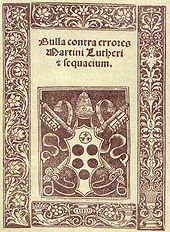 Pope Leo X's Bull against the errors of Martin Luther, 1521, commonly known as Exsurge Domine.
Pope Leo X's Bull against the errors of Martin Luther, 1521, commonly known as Exsurge Domine.On 15 June 1520, the Pope warned Luther with the papal bull (edict) Exsurge Domine that he risked excommunication unless he recanted 41 sentences drawn from his writings, including the 95 Theses, within 60 days. That autumn, Johann Eck proclaimed the bull in Meissen and other towns. Karl von Miltitz, a papal nuncio, attempted to broker a solution, but Luther, who had sent the Pope a copy of On the Freedom of a Christian in October, publicly set fire to the bull and decretals at Wittenberg on 10 December 1520,[60] an act he defended in Why the Pope and his Recent Book are Burned and Assertions Concerning All Articles. As a consequence, Luther was excommunicated by Pope Leo X on 3 January 1521, in the bull Decet Romanum Pontificem.
Martin Luther’s Reformation 573
The Reformation-Martin Luther, 8:42
https://youtu.be/EFqWnEpZvjs
Church Reaction to the Ninety-Five Theses 574
The Ninety-Five Theses on the Power and Efficacy of Indulgences (original Latin: Disputatio pro declaratione virtutis indulgentiarum) were written by Martin Luther and are widely regarded as the initial catalyst for the Protestant Reformation. The disputation protests against clerical abuses, especially nepotism, simony, usury, pluralism, and the sale of indulgences. It is generally believed that, according to university custom, on 31 October 1517, Luther posted the ninety-five theses, which he had composed in Latin, on the door of All Saints' Church in Wittenberg. However, contrary to popular belief, Luther merely passed around the pages, a move aided by the advent of the printing press around the same time[1][2].
 "Thesentür" (the "Door of the Theses") memorial at All Saints' Church (Schlosskirche) in Wittenberg
"Thesentür" (the "Door of the Theses") memorial at All Saints' Church (Schlosskirche) in Wittenberg Luther's 95 Thesis, 4:33
https://youtu.be/ijjbtcAEOnY
Luther’s Popular Appeal: The Vernacular Bible 574
The Luther Bible is a German language Bible translation from Hebrew and ancient Greek by Martin Luther. The New Testament was first published in 1522 and the complete Bible, containing the Old and New Testaments and Apocrypha, in 1534.
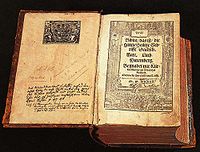 Martin Luther's 1534 bible
Martin Luther's 1534 bible The project absorbed Luther's later years.[4] Thanks to the then recently invented printing press,[5] the result was widely disseminated and contributed significantly to the development of today's modern High German language.
BIBLE IN PICTURES: THE LUTHER ILLUSTRATED BIBLE, 1:40
Title: BIBLE IN PICTURES: THE LUTHER ILLUSTRATED BIBLE Author: PROF. DR. STEPHAN FÜSSEL Format: Hardback Details: Martin Luther's Bible, published in 1534, was the first complete German Bible and a pivotal event in the history of Christianity. Luther's revolutionary translation, modern in vernacular and interpretation, made the Bible accessible to laypeople, fuelled anger and revulsion toward Rome and the Papacy, and begat a new religion, Protestantism. The most desirable copies came with shockingly graphic and politically-charged illustrations, such as those depicting the Whore of Babylon riding a seven-headed beast while wearing the Papal crown, or the Four Horsemen of the Apocalypse led by a Turkish soldier. Other illus are of powerful angels, Death on horseback and stories from the Bible like Susanna or Antiochus with his letter to the Jews. Taschen has published the 117 hand-coloured woodcut illustrations that triggered a religious revolution, created in the workshop of Lucas Cranach (1534). Each is meticulously reproduced from a rare and sumptuous original copy. Stephan Füssel provides a scholarly overview of Luther's life, the historic context and cultural significance of his Bible, and detailed descriptions of the illustrations and their iconography. Colour facsimile illus, by Taschen, 9" x 13½", 200 pages. Published Price: [Not Available] BIBLIOPHILE PRICE: £25.00
https://youtu.be/BVpLioPH70M
Reformation Music: The Chorale 575
In music, a chorale cantata is a sacred composition for voices and instruments, principally from the German Baroque era, in which the organizing principle is the words and music to a chorale. Usually a chorale cantata is in multiple movements or parts. Most chorale cantatas were written between approximately 1650 and 1750. By far the most famous are by J. S. Bach, especially the cantatas composed in his second annual cycle of cantatas, started in Leipzig in 1724.
German Choral Music of the Reformation, 2:33
Provided to YouTube by Smithsonian Folkways Recordings German Choral Music of the Reformation · n/a 2,000 Years of Music Compiled by and Released in Memory of Dr. Curt Sachs ℗ 2004 Smithsonian Folkways Recordings / 1962 Folkways Records Released on: 1962-01-01
https://youtu.be/CDH-sWMLlf8
Attack on Celibacy and Support of Charity 576
Martin Luther married Katharina von Bora, one of 12 nuns he had helped escape from the Nimbschen Cistercian convent in April 1523, when he arranged for them to be smuggled out in herring barrels.[92] "Suddenly, and while I was occupied with far different thoughts," he wrote to Wenceslaus Link, "the Lord has plunged me into marriage."[93] At the time of their marriage, Katharina was 26 years old and Luther was 41 years old.
 Katharina von Bora, Luther's wife, by Lucas Cranach the Elder, 1528
Katharina von Bora, Luther's wife, by Lucas Cranach the Elder, 1528 On 13 June 1525, the couple was engaged with Johannes Bugenhagen, Justus Jonas, Johannes Apel, Philipp Melanchthon and Lucas Cranach the Elder and his wife as witnesses.[94] On the evening of the same day, the couple was married by Bugenhagen.[94] The ceremonial walk to the church and the wedding banquet were left out, and were made up two weeks later on 27 June.[94]
Lutherhaus, Luther's residence in Wittenberg
Luther and his wife moved into a former monastery, "The Black Cloister," a wedding present from the new elector John the Steadfast (1525–32). They embarked on what appeared to have been a happy and successful marriage, though money was often short.[99] Between bearing six children, Hans – June 1526; Elizabeth – 10 December 1527, who died within a few months; Magdalene – 1529, who died in Luther's arms in 1542; Martin – 1531; Paul – January 1533; and Margaret – 1534; Katharina helped the couple earn a living by farming the land and taking in boarders.[100] Luther confided to Michael Stiefel on 11 August 1526: "My Katie is in all things so obliging and pleasing to me that I would not exchange my poverty for the riches of Croesus."[101]
No Apologies #100 - Indulgences-Scriptural, 4:36
Indulgences are often misunderstood. In the next few vlogs we want to answer some common objections and show that they are in fact an act of charity and mercy offered by the Church. Today we look at their biblical basis.
https://youtu.be/JZh9YGe1zZI
The Spread of the Reformation 576
Thomas Müntzer (ca. 1489 – 27 May 1525) was a German preacher and theologian of the early Reformation whose opposition to both Luther and the established Catholic church led to his open defiance of late-feudal authority in central Germany. Müntzer was foremost amongst those reformers who took issue with Luther’s compromises with feudal authority. He became a leader of the German peasant and plebeian uprising of 1525, was captured after the battle of Frankenhausen, and was tortured and executed.
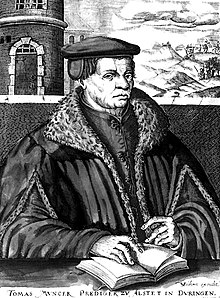 Thomas Müntzer, in a 1608 engraving by Christoffel Van Sichem.
Thomas Müntzer, in a 1608 engraving by Christoffel Van Sichem.No contemporary portrait of the reformer exists. This engraving may have been a copy of a picture made by Hans Holbein the Younger in Basel - but all evidence suggests that Holbein had left for France before Müntzer came to Basel in late 1524. Another possibility is that the original portrait was made by Sebald Beham, one of the 'three godless painters' of Nuremberg, when Müntzer was in that city in late 1524.
Few other figures of the German Reformation have raised so much controversy, which continues to this day, as Müntzer.[1] A complex and unique figure in history, he is now regarded as a significant player in the early years of the German Reformation and also in the history of European revolutionaries.[2] Almost all modern studies of Müntzer stress the necessity of understanding his revolutionary actions as a consequence of his theology: Müntzer believed that the end of the world was imminent and that it was the task of the true believers to aid God in ushering in a new era of history [3] Within the history of the Reformation, his contribution – especially in liturgy and Biblical exegesis – was of substance, but remains undervalued.
 Map showing the locations of the peasant uprisings and major battles
Map showing the locations of the peasant uprisings and major battles The German Peasants' War, Great Peasants' War or Great Peasants' Revolt (German: Deutscher Bauernkrieg) was a widespread popular revolt in the German-speaking areas of Central Europe from 1524 to 1525. It failed because of the intense opposition of the aristocracy, who slaughtered up to 100,000 of the 300,000 poorly armed peasants and farmers. The survivors were fined and achieved few if any of their goals. The war consisted, like the preceding Bundschuh movement and the Hussite Wars, of a series of both economic and religious revolts in which peasants and farmers, often supported by Protestant clergy, took the lead. The German Peasants' War was Europe's largest and most widespread popular uprising prior to the French Revolution of 1789. The fighting was at its height in the spring and summer of 1525.
The war began with separate insurrections, beginning in the southwestern part of what is now Germany and neighboring Alsace, and spread in subsequent insurrections to the central and eastern areas of Germany and present-day Austria.[1] After the uprising in Germany was suppressed, it flared briefly in several Swiss Cantons.
In mounting their insurrection, peasants faced insurmountable hurdles. The democratic nature of their movement left them without a command structure and they lacked artillery and cavalry. Most of them had little, if any, military experience. In combat they often turned and fled, and were massacred by their pursuers. The opposition had experienced military leaders, well-equipped and disciplined armies, and ample funding.
The revolt incorporated some principles and rhetoric from the emerging Protestant Reformation, through which the peasants sought freedom and influence. Historians have interpreted the economic aspects of the German Peasants' War differently, and social and cultural historians continue to disagree on its causes and nature.
Reformation Spread of Luther, 4:32
https://youtu.be/Gfv0BDrY26I
Thomas Müntzer and the Peasant War 576
Thomas Müntzer: The Battle of Frankenhausen_1 (The Mercenaries army of Hesse & Saxony), 3:24
The German peasant's war: The Battle of Frankenhausen1 (The Mercenaries army) 3D ANIM version
https://youtu.be/6-AVua_43nM
Luther - after the peasant war, 4:43
An uneasy peace came to Germany after the peasant uprising. Geo-political factors such as the threat of the Ottoman empire, and the various wars of both Pope and Holy Roman Emperor ensured that the focus would be broader than any one emerging European state. The long term effects of the German reformation were very great. The Protestant church became the vehicle of Christian protest and reform far more than Luther himself would have foreseen. The Reformation also gave rise to the counter-reformation, strengthening the influence of Roman Catholicism as the new world opened up for European exploitation of natural resources and later colonization.
https://youtu.be/V47KNRQQCzY
Huldrych Zwingli[a] or Ulrich Zwingli[b] (1 January 1484 – 11 October 1531) was a leader of the Reformation in Switzerland. Born during a time of emerging Swiss patriotism and increasing criticism of the Swiss mercenary system, he attended the University of Vienna and the University of Basel, a scholarly center of Renaissance humanism. He continued his studies while he served as a pastor in Glarus and later in Einsiedeln, where he was influenced by the writings of Erasmus.
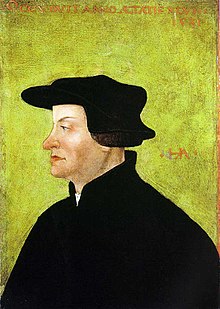 Huldrych Zwingli as depicted by Hans Asper in an oil portrait from 1531 (Kunstmuseum Winterthur)
Huldrych Zwingli as depicted by Hans Asper in an oil portrait from 1531 (Kunstmuseum Winterthur) In 1518, Zwingli became the pastor of the Grossmünster in Zurich where he began to preach ideas on reforming the Catholic Church. In his first public controversy in 1522, he attacked the custom of fasting during Lent. In his publications, he noted corruption in the ecclesiastical hierarchy, promoted clerical marriage, and attacked the use of images in places of worship. In 1525, Zwingli introduced a new communion liturgy to replace the Mass. Zwingli also clashed with the Anabaptists, which resulted in their persecution. Historians have debated whether or not he turned Zurich into a theocracy.[1]
The Reformation spread to other parts of the Swiss Confederation, but several cantons resisted, preferring to remain Catholic. Zwingli formed an alliance of Reformed cantons which divided the Confederation along religious lines. In 1529, a war between the two sides was averted at the last moment. Meanwhile, Zwingli's ideas came to the attention of Martin Luther and other reformers. They met at the Marburg Colloquy and although they agreed on many points of doctrine, they could not reach an accord on the doctrine of the Real Presence of Christ in the Eucharist.
In 1531 Zwingli's alliance applied an unsuccessful food blockade on the Catholic cantons. The cantons responded with an attack at a moment when Zurich was ill prepared. Zwingli was killed in battle at the age of 47. His legacy lives on in the confessions, liturgy, and church orders of the Reformed churches of today.
Ulrich Zwingli in Zurich 577
Ulrich Zwingli, 3:05
https://youtu.be/Inlc10swJWw
John Calvin in Geneva 578
John Calvin (/ˈkælvɪn/;[1] French: Jean Calvin, pronounced: [ʒɑ̃ kalvɛ̃]; born Jehan Cauvin: 10 July 1509 – 27 May 1564) was an influential French theologian and pastor during the Protestant Reformation. He was a principal figure in the development of the system of Christian theology later called Calvinism, aspects of which include the doctrine of predestination and the absolute sovereignty of God in salvation of the human soul from death and eternal damnation. In these areas Calvin was influenced by the Augustinian tradition. Various Congregational, Reformed and Presbyterian churches, which look to Calvin as the chief expositor of their beliefs, have spread throughout the world.
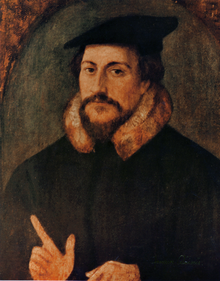 Portrait attributed to Hans Holbein the Younger
Portrait attributed to Hans Holbein the Younger Calvin was a tireless polemic and apologetic writer who generated much controversy. He also exchanged cordial and supportive letters with many reformers, including Philipp Melanchthon and Heinrich Bullinger. In addition to his seminal work Institutes of the Christian Religion, he wrote commentaries on most books of the Bible, as well as theological treatises and confessional documents.
Originally trained as a humanist lawyer, he broke from the Roman Catholic Church around 1530. After religious tensions provoked a violent uprising against Protestantism in France, Calvin fled to Basel, Switzerland, where he published the first edition of the Institutes in 1536. In that year, Calvin was recruited by another Frenchman William Farel to help reform the church in Geneva, where he regularly preached sermons throughout the week. The city council resisted the implementation of Calvin's and Farel's ideas, and both men were expelled. At the invitation of Martin Bucer, Calvin proceeded to Strasbourg, where he became the minister of a church of French refugees. He continued to support the reform movement in Geneva, and was eventually invited back to lead its church.
Following his return, Calvin introduced new forms of church government and liturgy, despite opposition from several powerful families in the city who tried to curb his authority. During this period, Michael Servetus, a Spaniard regarded by both Catholics and Protestants as having heretical views, arrived in Geneva. He was denounced by Calvin and burned at the stake for heresy by the city council. Following an influx of supportive refugees and new elections to the city council, Calvin's opponents were forced out. Calvin spent his final years promoting the Reformation both in Geneva and throughout Europe.
John Calvin And The Reformation, 3:40
https://youtu.be/BNpanuF3RA8
Protestant Anti-Semitism 579
German for "Jews' sow", Judensau was the derogatory and dehumanizing imagery of Jews that appeared around the 13th century. Its popularity lasted for over 600 years and was revived by the Nazis. The Jews, typically portrayed in obscene contact with unclean animals such as pigs or owls or representing a devil, appeared on cathedral or church ceilings, pillars, utensils, etchings, etc. Often, the images combined several antisemitic motifs and included derisive prose or poetry.
"Dozens of Judensaus... intersect with the portrayal of the Jew as a Christ killer. Various illustrations of the murder of Simon of Trent blended images of Judensau, the devil, the murder of little Simon himself, and the Crucifixion. In the 17th-century engraving from Frankfurt...[18] a well-dressed, very contemporary-looking Jew has mounted the sow backward and holds her tail, while a second Jew sucks at her milk and a third eats her feces. The horned devil, himself wearing a Jewish badge, looks on and the butchered Simon, splayed as if on a cross, appears on a panel above."[19]In Shakespeare's "Merchant of Venice", considered to be one of the greatest romantic comedies of all time, the villain Shylock was a Jewish moneylender. By the end of the play he is mocked on the streets after his daughter elopes with a Christian. Shylock, then, compulsorily converts to Christianity as a part of a deal gone wrong. This has raised profound implications regarding Shakespeare and antisemitism.[20]
During the Middle Ages, the story of Jephonias,[21] the Jew who tried to overturn Mary's funeral bier, changed from his converting to Christianity into his simply having his hands cut off by an angel.[22]
A 15th-century German woodcut showing an alleged host desecration.
1: the hosts are stolen
2: the hosts bleed when pierced by a Jew
3: the Jews are arrested
4: they are burned alive.
1: the hosts are stolen
2: the hosts bleed when pierced by a Jew
3: the Jews are arrested
4: they are burned alive.
Martin Luther the Great Protestant Reformer on Anti-Semitism, and Treatment of the Jews, 2:12
https://youtu.be/YGWGA6zsq50
The Printing Press: A Force for Ideas and Art 579
Printing with Gutenberg: The Printing Press, 1:30
https://youtu.be/HlGLpojorY0
Johannes Gutenberg- The Printing Press, 7:04
Johannes Gutenberg invented the 'Western' world's first metal moveable type printing press. Western civilization had long been using a phonetic alphabet, dating back to a Semitic alphabet around 1500 BC. It was not until 1400 AD that Europeans first began using carved wooden blocks applied with ink to print religious messages. On AUGUST 24, 1455, Gutenberg printed his masterpiece, the Gutenberg Bible, regarded as the first book of significance ever printed. No longer copied tediously by hand and chained to pulpits, Bibles were soon mass produced. Gutenberg, whose name means "beautiful mountain," wrote of his 42-line Gutenberg Bible, also called the Mazarin Bible, 1455: "God suffers in the multitude of souls whom His word can not reach. Religious truth is imprisoned in a small number of manuscript books which confine instead of spread the public treasure. Let us break the seal which seals up holy things and give wings to Truth in order that she may win every soul that comes into the world by her word no longer written at great expense by hands easily palsied, but multiplied like the wind by an untiring machine..."
https://youtu.be/UmX8xpj_IxE
Printmaking: Book Illustration and Fine Art 580
The Seven New Powers of Book Design - Printing Press, 2:53
Watch one of the most remarkable transformations in the history of writing, as the Western world switched from a multi-sensory, holistic, visually stimulating way of consuming information, to an entirely black and white, dry, empirical method... Excerpts from the standing room only presentation delivered at the NSA Annual Convention in San Diego, July 10, 2007. Topics covered in this video series: gutenberg, gutenberg printing press, printing press, color and the brain, neuroscience of color, fonts, books and fonts, typography, book shape, book branding, book packaging, book packagers, book designers, book marketing, differentiation, viral book marketing, book Renaissance, publishing Renaissance, illuminated manuscripts, self-publishing, jeffrey gitomer, tom peters, nick bantock, louise hay, jon stewart, milton glaser, i love new york, john assaraf, photography, illustrated books bestseller bestsellers business.
https://youtu.be/g6Hr1P3F-M4
Gutenberg Printing Press vs Digital Revolution, 4:03
https://youtu.be/xWka8vYzqHM
Writing for Print: The New Humanists 583
The Printing Revolution (Renaissance and Reformation Part 3), 1:13
http://www.zaneeducation.com - The Printing Revolution is Part 3 of Renaissance and Reformation - a History Through Literature Title Learn about humanism and identify its origins in the literature of ancient Greece and Rome, and describe how European writers rediscovered humanist ideals. Identify some of the important events that happened in world history during the Renaissance and Reformation, between 1400 and 1660 and name some of the authors who lived and wrote during this time. Discover the mercantile system and how it increased the power of the monarchy and caused the merchant class to prosper and expand. Learn about the siglo de oro (golden century) in Spanish literature and the Elizabethan age in English literature, identifying some of the important writers of each movement. Zane Education owns the largest library of K-12 curriculum-based subtitled video currently available online. Each video is fully subtitled so as to enable each student to study the topic and improve their reading and literacy skills at the same time.
https://youtu.be/_HrvMPdJCzs
From Religious to Secular Art 587
What Was Renaissance Art? AP Euro Bit by Bit #6, 8:14
This video is about the role of art in the Renaissance. In it, I introduce the new techniques developed by artists of the time and highlight the Italian Renaissance, High Renaissance, and Northern Renaissance. Along the way, I introduce you to some of the major artists of each period.
https://youtu.be/8JesvbqPglY
Dürer’s Protestant Imagery 587
Best of Pawn Stars: Albrecht Durer Print | History, 2:56
Rick gambles on a print of an Albrecht Durer etching that turns out to be worth quite a bit more than he'd hoped in this scene from "Best of Pawn.
https://youtu.be/svLxiWEZ1JI
Landscapes, Cycles, and Still Lifes 588
READINGS
17.1 from Desiderius Erasmus, Julius Excluded from Heaven (1513) 571
17.2a–b from Desiderius Erasmus, In Praise of Folly (1509) 572
17.3 from Martin Luther, Preface to Works (1545) 573
17.4 from Martin Luther, Ninety-Five Theses (1517) 593
17.5 from Martin Luther, Against the Robbing and Murdering Hordes of Peasants (1525) 577
17.6 from François Rabelais, Gargantua and Pantagruel, Book 2, Chapter 7 (1532) 583
17.7 from Michel de Montaigne, “Of Cannibals” (1580) 594
FEATURES
MATERIALS & TECHNIQUES Printmaking 581
CLOSER LOOK Dürer’s Adam and Eve 584
CONTINUITY & CHANGE The Church Strikes Back 591
18 Encounter and Confrontation THE IMPACT OF INCREASING GLOBAL INTERACTION 597
The Spanish in the Americas 600
Pizarro in Peru 600
Gold and Silver: The Monetary Motive 601
West African Culture and the Portuguese 605
Kingdom of the Kongo 607
Strategies of Cultural Survival: The Dance 608
Strategies of Cultural Survival: Communicating with the Spirit World 610
The Slave Trade: Africans in the Americas 612
The Arab Muslim Slave Trade Of Africans, The Untold Story, 8:40
Muslim Arabs hunted, enslaved, tortured and killed ethnic Africans for a millennium. Middle Eastern Muslim Arabs have a history of over 1400 years of human slavery, which even continues today in the Middle East. Arab Muslims controlled, maintained, initiated slavery of ethnic Africans. Islams Arab prophet Muhammad himself brought, kept and sold African slaves. Sahih Muslim Book 10 Number 3901 Jabir (Allah be pleased with him) reported: There came a slave and pledg- ed allegiance to Allah's Apostle (may peace be upon him) on migration; he (the Holy Prophet) did not know that he was a slave. Then there came his master and demanded him back, whereupon Allah's Apostle (may peace be upon him) said: Sell him to me. And he bought him for two black slaves, and he did not afterwards take allegiance from anyone until he had asked him whether he was a slave (or a free man).
https://youtu.be/8zM_MzkLKPY
Saudi Arabs Are Still Selling Castrated Black Slaves TODAY, 3:46
https://youtu.be/5XzThnFyjG0
India and Europe: Cross-Cultural Connections 614
Islamic India: The Taste for Western Art 614
Mogul Architecture: The Taj Mahal 616
China: The Ming Dynasty (1368–1644) 617
The Treasure Fleet: Extending China’s Influence 619
Luxury Arts 620
Painting and Poetry: Competing Schools 620
Japan: Court Patronage and Spiritual Practice 622
The Muromachi Period (1392–1573): Cultural Patronage 623
The Azuchi-Momoyama Period (1573–1615): Foreign Influences 626
The Closing of Japan 628
READINGS
18.1 from Bernadino de Sahagün, History of the Things of New Spain (ca. 1585) 631
18.2 from Bernal Diaz, True History of the Conquest of New Spain (ca. 1568; published 1632) 600
18.3 from Fray Juan de Torquemada, Indian Monarchies (1615) 613
18.4 Shah Jahan, inscription on the Taj Mahal (ca. 1658) 617
18.5 Zeami Motokiyo, Semimaru (early 15th century) 632
18.6 from Zeami Motokiyo, “The One Mind Linking All Powers” (early 15th century) 626
FEATURES
CLOSER LOOK Folding Screen with Indian Wedding and Flying Pole 602
CONTEXT The “Other” in Western Consciousness 604
MATERIALS & TECHNIQUES Porcelain 621
CONTINUITY & CHANGE The Influence of Zen Buddhism 629
Bach Chorale
The core of www.jsbchorales.net is the set of four-part harmonized chorales.
http://www.jsbchorales.net/index.shtml
Catholic Counter Reformation Notes, 9:56
http://youtu.be/bQr3alVXkLQ



